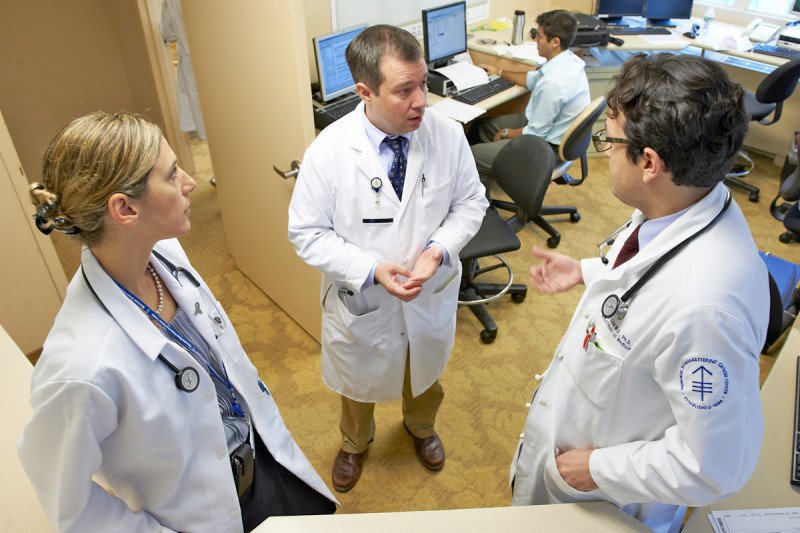
Expertise in Rare Cancers -- Working at a medical center that specializes in cancer means that medical oncologist Gregory Riely (center) and a team of Memorial Sloan Kettering physicians are experienced in caring for patients with uncommon thymic tumors.
The thymus is a small organ located beneath the breastbone in the chest that functions as part of the lymphatic system, the body’s network for transporting infection-fighting white blood cells (lymphocytes) throughout the body.
It produces T-lymphocytes and prompts B-lymphocytes to make antibodies that fight bacteria. The thymus is most active during childhood, reaches its greatest size at puberty, and gradually shrinks in adulthood.
Types of Thymic Tumors
Tumors of the thymus gland are uncommon, accounting for less than one percent of all cancers. There are three types.
Thymoma
About 90 percent of tumors that develop in the thymus are thymomas. These tumors begin in the cells that line the outside of the thymus and tend to grow slowly. It’s rare for them to spread outside of the thymus. However, there are situations in which thymomas are aggressive and spread to neighboring organs in the chest or the lining of the lung (the pleura).
Approximately 500 Americans are diagnosed with thymomas each year, most of them between the ages of 40 and 60. In many cases doctors discover the tumor when treating the person for an unrelated illness.
For example, the autoimmune disorder myasthenia gravis is found in a third of people with thymomas. With this illness, nerve impulses are not transmitted properly to muscles, which can result in severe muscle weakness. This often affects muscles that control eye and eyelid movement, facial expression, and swallowing.
About one in ten people with thymomas have a form of anemia known as red cell aplasia, or hypogammaglobulinemia. This deficiency of immune-fighting gamma globulins increases susceptibility to infections.
Thymic Carcinoma
As many as one in ten thymic tumors are found to be thymic carcinoma. Thymic carcinomas can grow more quickly than thymomas and can sometimes spread outside the thymus. These tumors sometimes require combinations of different therapies, such as chemotherapy or radiation in addition to surgery.
Thymic Carcinoids
Thymic carcinoids are rare and slow-growing cancers, also known as neuroendocrine tumors. They more commonly arise in the digestive tract and lungs, but on rare occasions can also appear in the thymus gland. They occur more frequently in men than in women and are more likely than thymomas to spread or recur.
The rare genetic disorder multiple endocrine neoplasia (MEN) syndrome is sometimes associated with thymic carcinoids because it can prompt the parathyroid glands, pituitary gland, and pancreas to produce too many hormones.
Symptoms
Many people don’t experience any symptoms with tumors of the thymus and are found to have the illness only as a result of testing for other conditions. When symptoms are present, they can include a persistent cough, muscle weakness, chest pressure or pain, or trouble breathing.
Occasionally when a person has a thymic carcinoid, the body may make too much of a substance called ACTH, which causes the adrenal glands to produce excess cortisol and other hormones, leading to weight gain, muscle weakness, diabetes, increased body and facial hair, and thin or darkened skin (Cushing’s syndrome).
We’re available 24 hours a day, 7 days a week
